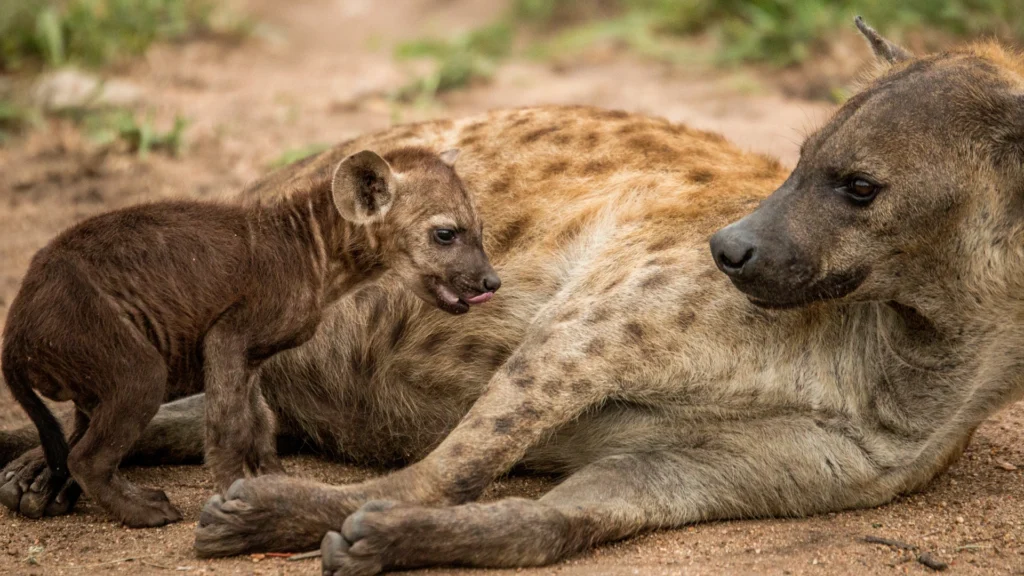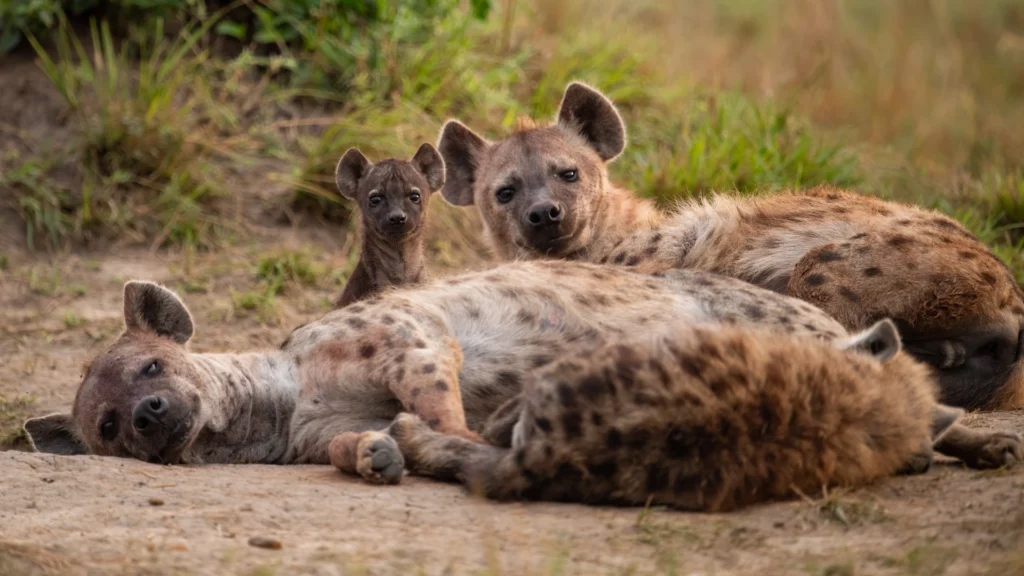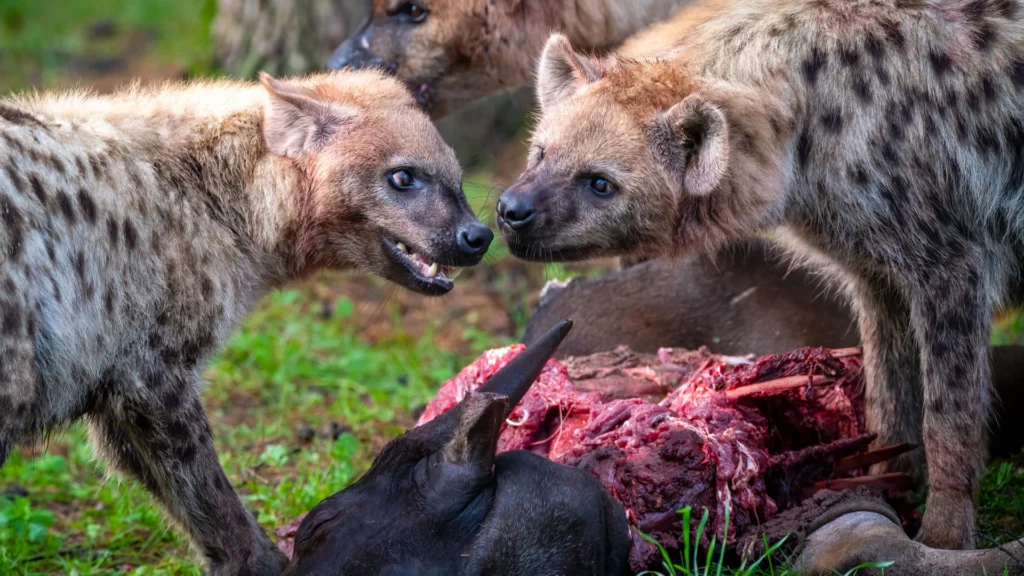Introduction
The spotted hyena (Crocuta crocuta) is the largest of three hyena species, the brown and the striped hyena being the other two. Hyenas can be found across Africa, through the Arabian Peninsula and into India.
There are an estimated 27,000 to 47,000 hyenas in the wild and although the spotted hyena is not endangered, these numbers are alarmingly low and are steadily decreasing. The spotted hyena is severely threatened by habitat loss and human-wildlife conflict.1https://www.iucnredlist.org/species/5674/45194782#population
In Uganda, the highest populations of spotted hyenas can be found on the savannahs of Queen Elizabeth National Park, Murchison Falls National Park and Kidepo Valley National Park and even in the mountainous forest of Mgahinga National Park.2https://destinationuganda.com/animals/spotted-hyena/ Hyenas can live to 25 years old in the wild, weigh up to 13 stone (85 kg), and their head and body can reach 5 feet (1.5 m) long.3https://www.nationalgeographic.com/animals/mammals/facts/spotted-hyena
Fascinating facts
No one’s laughing

Spotted hyenas are infamously known as the laughing hyena due to the distinct calls they make. Although their vocalisation has given them the reputation of a mischievous trouble-maker, the ‘laugh’ actually signals upset or distress.2https://destinationuganda.com/animals/spotted-hyena/
Closer to a cat

With their big round ears and dog-like nose, hyenas might look like a bear crossed with a dog but they’re actually more closely related to cats. Their closest relatives include cats, mongooses and civets.3https://www.nationalgeographic.com/animals/mammals/facts/spotted-hyena
Mum knows best

Spotted hyenas are matriarchal and live in groups called clans, with a female in charge. Each clan has from six to 100 members led by an alpha-female.4https://sitn.hms.harvard.edu/flash/2019/hyenas-probably-have-more-friends-than-you-spotted-hyena-social-hierarchie Much like a royal family, the children of the dominant female automatically inherit the rank just below her and will be next in line for the throne.
Girls on top

Female hyenas are only slightly larger than males, but this difference – along with their stronger aggression – has been used to explain why females dominate the clan. Another ‘male’ characteristic was thought to be the fact they the females have a pseudopenis. In fact, this body part is a large and elongated 20 cm clitoris that looks like a penis and encourages enjoyment of sex. Instead of a separate vagina and urethra, the elongated clitoris contains a single urogenital canal used to wee, have sex, and bear offspring.
In fact, a study of spotted hyena social behaviour suggests that social support is more predictive of a hyena’s dominance than size and aggression. If a female has more hyenas on her side, she’s more likely to come but trumps in a social challenge.5https://www.nature.com/articles/s41559-018-0718-9?WT.feed_name=subjects_behavioural-ecology
Time for cuddles

Spotted hyenas are affectionate with each other, often resting or sleeping cuddled together.
Females take their pick

The alpha-females of the clan get to choose which male to mate with. They usually go for males who have been in the clan the longest, and who have a relaxed personality rather than the more aggressive ones. After about 103 days, the female gives birth to one to four cubs, but twins are most common.6https://www.pbs.org/wnet/nature/animal-guide-spotted-hyena/
Hyenas are expert hunters

Many people think that hyenas just scavenge rotting carcasses but the truth is that spotted hyenas hunt at least half of their food.4https://sitn.hms.harvard.edu/flash/2019/hyenas-probably-have-more-friends-than-you-spotted-hyena-social-hierarchie Spotted hyenas often hunt alone but join cooperatively to take larger prey. Although they might look like muscular sprinters, they are actually made for endurance and chase their prey in packs for a long time until their prey is exhausted and collapses. Hyenas have been known to hunt animals as large as baby elephants, giraffes, zebras and buffalo but will eat smaller animals like birds, lizards and insects too. Higher ranking females and their offspring have first dibs, showing where social dominance hierarchies matter – access to food.4https://sitn.hms.harvard.edu/flash/2019/hyenas-probably-have-more-friends-than-you-spotted-hyena-social-hierarchie
Hyenas have one of the strongest jaws in the animal kingdom

The powerful jaw of a hyena can reach 1100 psi of pressure.7https://www.sciencefocus.com/nature/top-10-which-animals-have-the-strongest-bite With that much strength they can easily crush rhino bones in their teeth and their super stomach acid can digest the shards and extract the bone marrow within.
Hyenas are eco-warriors

By consuming carrion, spotted hyenas are maintaining a healthy ecosystem. They return important nutrients to the soil and reduce the spread of disease by disposing of rotting carcasses. By preying on sick and weak individuals, they reduce the risk of infectious disease outbreaks amongst the prey animals and control their population.8https://cdr.lib.unc.edu/downloads/sq87c455b#:~:text=Habitat%20loss%2C%20human%2Dhyena%20conflict,primary%20threats%20to%20the%20species
Threats to spotted hyenas
Habitat loss
As for all animals in Uganda, habitat loss is a constant and worsening threat to spotted hyenas. With land being lost to human settlements, roads and agriculture, hyenas have less space and fewer animals to hunt, leading to human-wildlife conflict. With less land to roam, conflict between rival clans of hyenas also becomes more common, resulting in more deaths among the clans. However, it is certainly human-hyena conflict that poses the biggest threat to spotted hyenas.
Human-wildlife conflict
As the human population of Uganda increases and people encroach into the natural habitat of hyenas, interactions become more common. Hyenas are intelligent and bold, and are not afraid to raid food stores and crops, and they are often blamed for killing farmed animals. In a callous act of revenge, hyenas are hunted down and cruelly killed. A 2022 study of the causes of death of spotted hyenas in Africa found that most commonly poison is used for retribution.8https://cdr.lib.unc.edu/downloads/sq87c455b#:~:text=Habitat%20loss%2C%20human%2Dhyena%20conflict,primary%20threats%20to%20the%20species The same study pointed out that a ‘“strong dislike for spotted hyenas seems to be entrenched in many cultures across the species’ geographic range”, acknowledging the importance of education so that future generations do not hold the same misconceptions about hyenas.
Animal agriculture lies at the heart of the threats to hyenas. Animal agriculture requires far more land and resources than growing crops for humans – this is because land is not only used for grazing but also for growing food for the animals. The more animal-based foods we eat, the more endangered the natural habitats become. Crops are a far more efficient way to feed the growing population of Uganda and use less land and other natural resources. A vegan diet is associated with only half the cropland demand, grazing intensity and overall biomass harvest of meat-based diets9https://www.nature.com/articles/ncomms11382 so switching to a vegan diet would have a phenomenal impact on reducing habitat loss and land degradation in Uganda. What’s more, with fewer farmed animals, and more naturally occurring prey, hyenas would not have to raid farms as often, or at all, and would therefore not be subject to poisoning and ensnaring by angry farmers.
References
References
- 1
- 2
- 3
- 4
- 5
- 6
- 7
- 8
- 9

